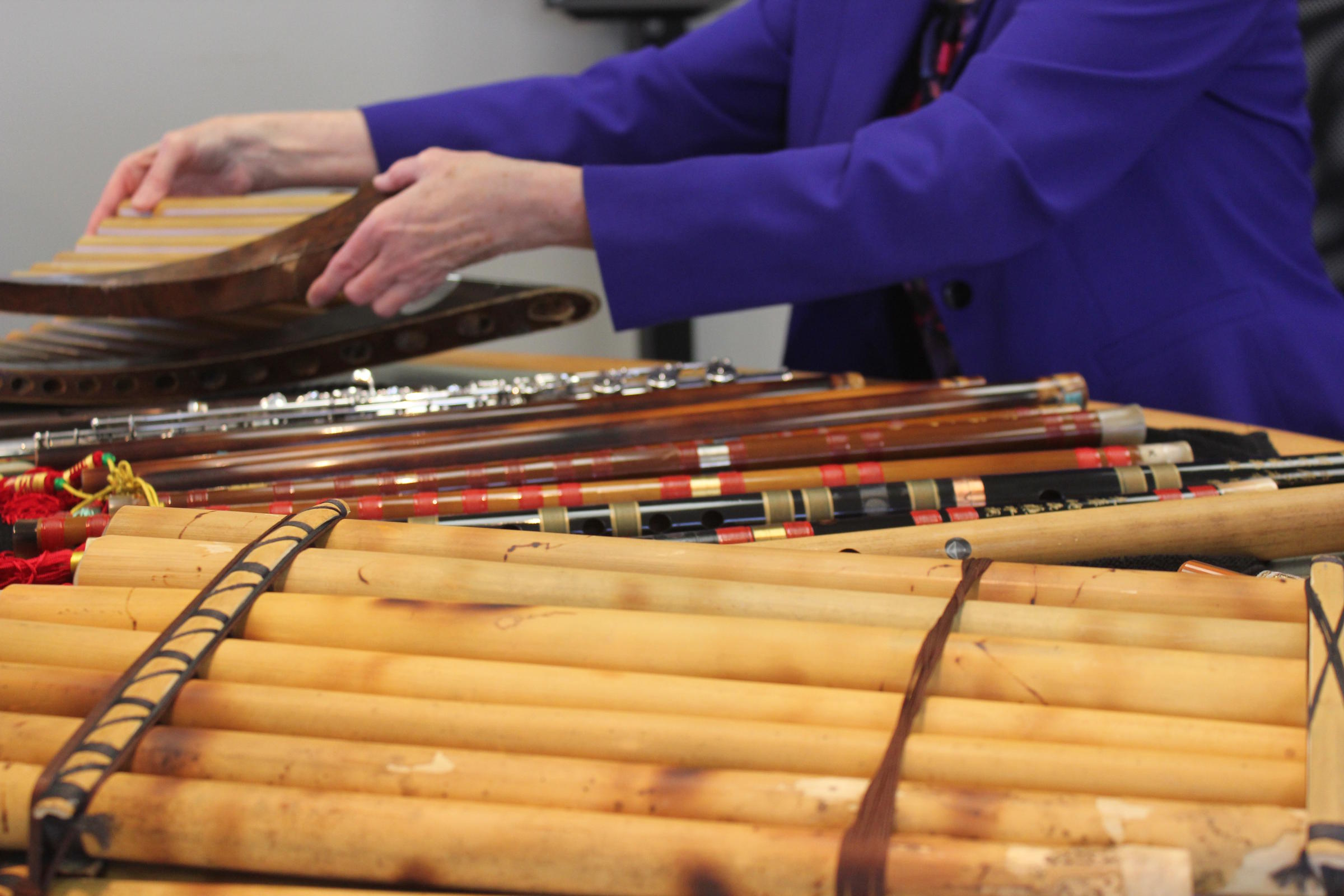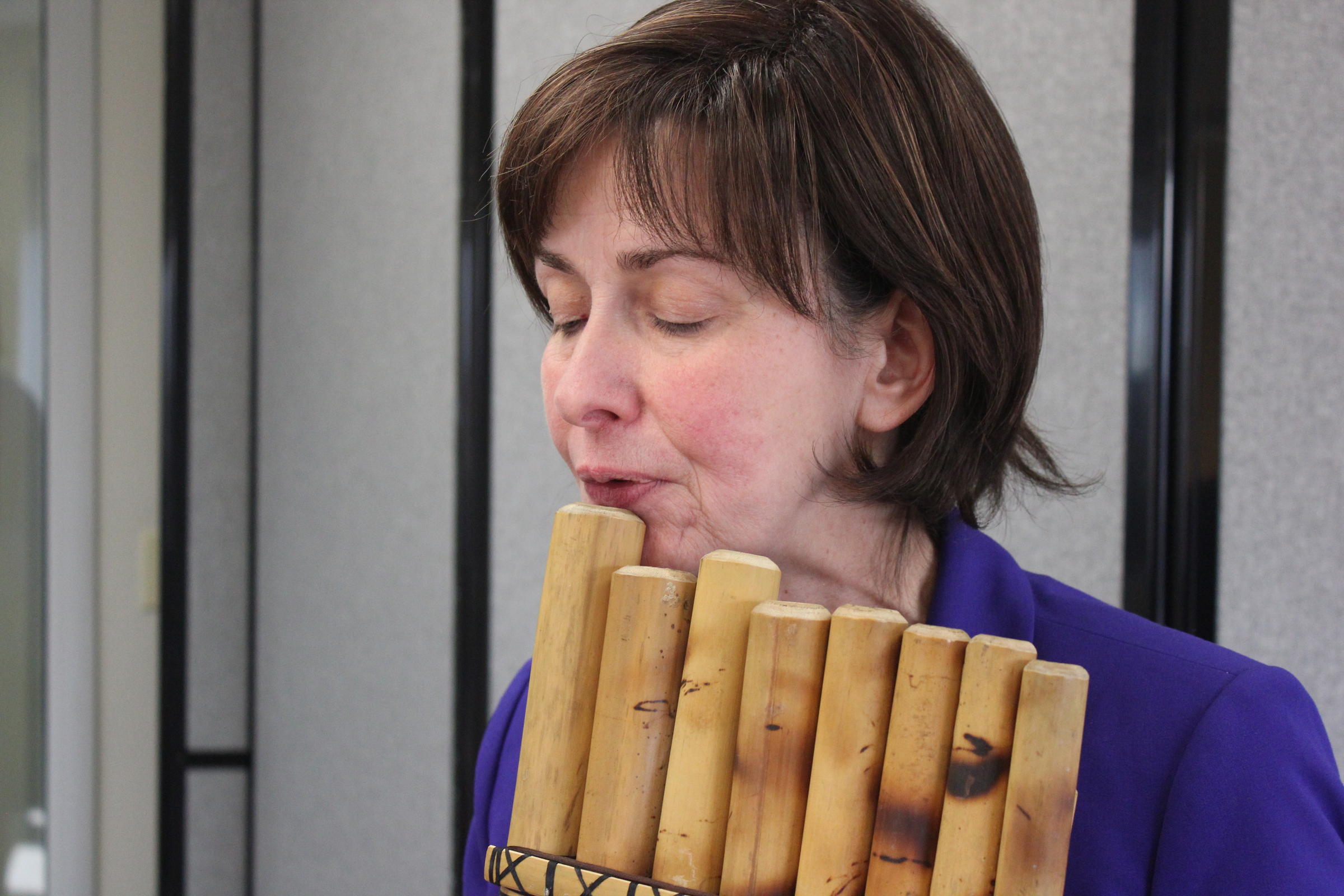 |
| Kay Ragsdale and the flutes of The Lion King |
It is with a heavy heart that I offer this tribute in memorium to one of
the kindest and most generous people that I have known. Kay Ragsdale was a fine
person and excellent flutist who loved her work and was happy to share her joy in
her flute collection with anyone who was interested. It was more than a flute
collection to her; it was a way of life. For every ethnic flute she owned she
sought out a master to teach her the ways of the instrument. She learned not
only how to play the flutes with their respective traditional techniques, but
also their history and folklore. I will always cherish the time I spent with her, remembering her generous spirit, infectious laugh and amazing knowledge about flutes and cultures of the world.
This is a transcript of a lecture demonstration given by Kay
Ragsdale, the flutist who travels with the Gazelle Tour of The Lion King. She has a magnificent collection of ethnic flutes
from all over the world, as well as novelty flutes from different cultures and
fascinating stories to go with the instruments. Not all the flutes she owns are
played in the show. The Lion King flute book requires fifteen instruments (that’s
a lot of doubling!) but she transports about 80 flutes in the instrument truck,
some as back-ups in case a bamboo flute develops a crack, and some she carries
with her so she can give demonstrations to groups in the cities where the show
is playing. She offered to give a demonstration in Detroit when the show was at
the opera house in 2008 and what follows are highlights from a transcription of
the lecture she gave to the lucky few who were assembled there.
Kay also offered to any flute student the chance to sit with
her during a show and experience The Lion King from the pit, an opportunity that
two of my students took. It was a unique experience which they will always
remember. At the end of the show she gave each of them a little clay bird
ocarina which chirps when you put water in it and blow through the tail.

Highlights from Kay’s lecture in Detroit:
“One of my favorite things, and I’ve actually had to use
this, is a cane. It’s a walking stick flute. These were very popular in Victorian
England. The Dayton C. Miller collection at the Library of Congress in
Washington, D.C. has the largest collection of walking stick flutes of any
country. Some had detachable piccolos and a bird whistle in the handle. Of
course, only wealthy men had walking sticks but the women, not wanting to be
left out, installed little music boxes in their bustles which would play
their signature tune whenever they sat down. We do know that Queen Victoria’s
bustle played “God Save the Queen” when she sat down.
“Now, of course you all know what this is - it’s a Nose flute. it has three holes so you only use one hand to finger the notes and with the other hand you close off the other side of your nose, if you need to change sides, then you change hands. Very practical. They make different sized flutes for different keys. While a lot of these cultures talk about the sacredness of the air the cultures that use nose flutes, such as Africa and in the South Pacific islands, believe the air you use through your nose is better than the air through your mouth because you can’t say anything bad about anybody with your nose.
“Now, of course you all know what this is - it’s a Nose flute. it has three holes so you only use one hand to finger the notes and with the other hand you close off the other side of your nose, if you need to change sides, then you change hands. Very practical. They make different sized flutes for different keys. While a lot of these cultures talk about the sacredness of the air the cultures that use nose flutes, such as Africa and in the South Pacific islands, believe the air you use through your nose is better than the air through your mouth because you can’t say anything bad about anybody with your nose.

“One of my favorite categories of flutes are clay vessel flutes known as Ocarinas. They make nice necklaces when you put them on a string and wear them around your neck. An interesting period in Victorian England was when the Victorians thought they could teach baby birds how to sing better than the birds’ mothers. But it turned out that the whole experiment was a disaster. None of them learned their correct species song, none of them could attract a mate or reproduce and they all died. But what we have left from that are these little clay bird whistles which, when you put water in the hole in the top and blow through the hole in the tail, it chirps.
“You can always tell a Bansuri flute from India because they
are not decorated. In ancient India a flutist dedicates his life to playing the
flute. Now we use clocks but in ancient times the flute player marked the passage of time by playing
different sized flutes, starting out by playing the smallest flute before dawn
and ending up by playing the largest flute at midnight. The largest one has about the range of our
modern alto flute but without keys to help cover the holes. As the flutes get
larger the holes get bigger and harder to cover as the spacing is more distant;
so flute players were selected at a very young age and had the skin between
the fingers cut so the fingers could stretch out as the flute player grew and their fingers would be able to cover
the holes. (groans from the audience)
“Now let’s go to China. Chinese d’tzi were highly decorated.
They believe that the eye is to be delighted
as well as the ear. They come in two colors, black and brown. Sometimes stories
and poems are written on them as part of the decoration. In many cultures the flutes can be played to the right or the left. The right and left hands are in the same position so you can play it in either direction. Hand position is different than modern western flute; balance points are the chin and each thumb, not the cradle position that we use. There is an extra hole
between the embouchure hole and finger holes where you place a membrane, called dimo, made
from the interior of a bamboo plant. It's like very fragile tissue paper and causes it to sound like a kazoo. You can place the grain either
horizontally or vertically over the hole, traditionally sticking it on with a
bit of garlic juice. The d’tzi are smoked and when you get a new one they smell
like ham. To maintain these instruments you need to treat them with mustard
seed oil. So, with ham, mustard and
garlic, depending on their preference for lunch, your friends might want to sit
closer to you or farther away.

“Only the samurai warriers were allowed to play the shakuhachi. Women and children were not allowed to touch
it. Ordinary men were not allowed to touch it either. The samurai studied two things: sword and flute because they shared two
elements - breathing and concentration. In battle if you were to lose your
sword, you could whip out your flute and use it as a club against your opponent.
“The ancient Greek mythological figure, Pan was half man, half
goat. One day he was chasing after the wood nymph Syrinx, who wisely ran to the river’s edge
where she implored the river god to help her and was changed into a reed, along with her sisters. Not being able to find her, Pan was very
disconsolate so he gathered some reeds by the river and cut them into
different lengths. He then made the instrument which we call
the Pan Pipe and he brought Syrinx back to life by blowing across the edge of
the tubes. The ultimate tragedy was that Pan killed that which he
loved the most, but do not despair because every time
someone plays on a pan flute, Syrinx will be brought back to life.

“Lion King has the
greatest flute part ever. I look forward to playing the show every day. I get
nervous before every show and at the end I say, “That was really fun, let’s do
it again!” so I get another chance to play it. That’s the great thing about it - you get the chance to play multiple repetitions. One thing I've learned is to never give up or get dissuaded
by anything anyone says. I didn’t listen to anyone when they told me I couldn't do it. If you’re interested in
something, just explore it on your own.”
After about an hour and a half of fascinating flute lore, we
ran out of time for Kay to show us her crystal flute and many others, I
suspect, but we came away with her deep love for what she does and her
generosity of spirit in sharing her passion with others.
RIP, Kay and thank-you for enriching the world with everything you have given us.

Flutes as canes and flutes as clubs -- fascinating! A wonderful lecture and wonderful tribute.
ReplyDelete